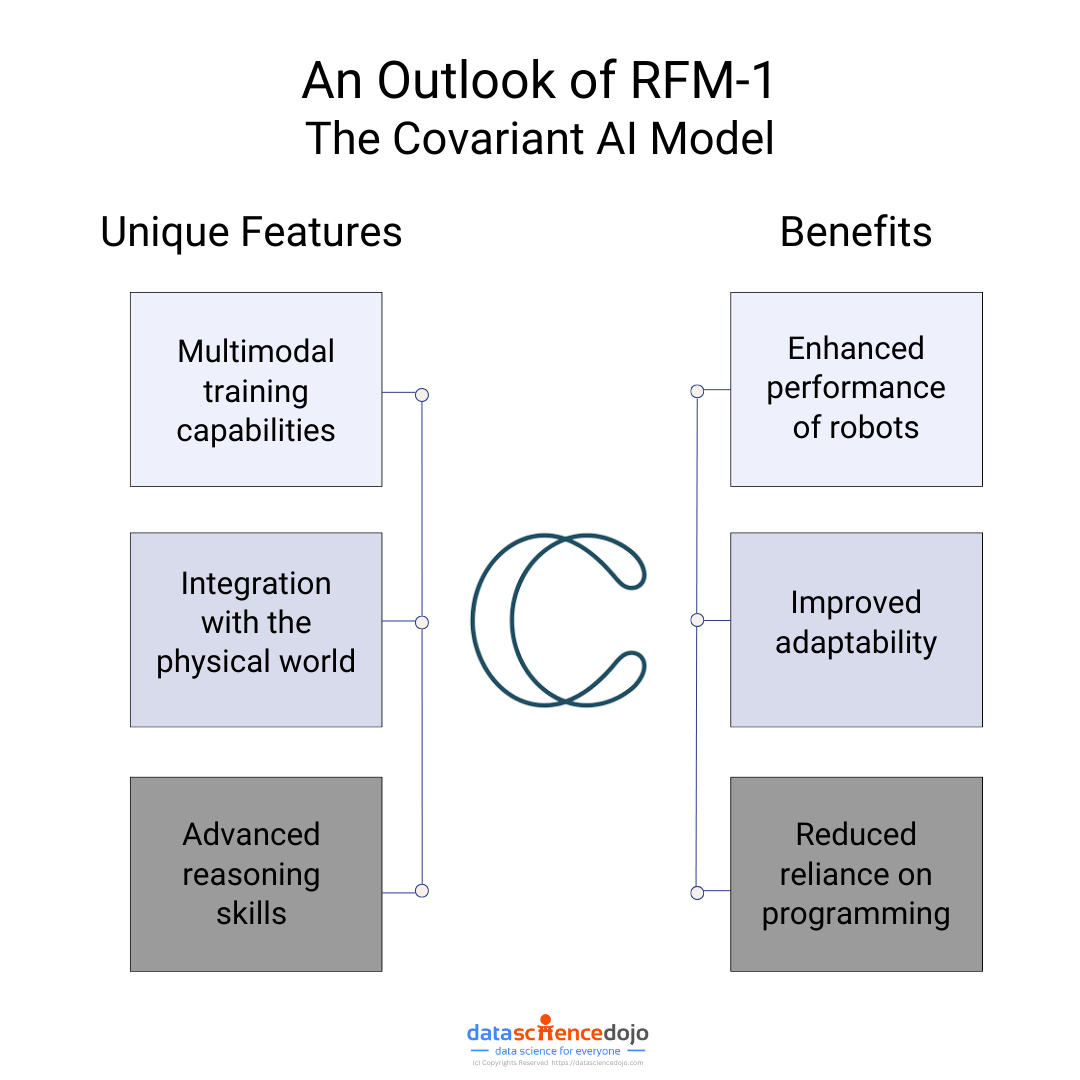Covariant AI has emerged in the news with the introduction of its new model called RFM-1. The development has created a new promising avenue of exploration where humans and robots come together. With its progress and successful integration into real-world applications, it can unlock a new generation of AI advancements.
Explore the potential of generative AI and LLMs for non-profit organizations
In this blog, we take a closer look at the company and its new model.
What is Covariant AI?
The company develops AI-powered robots for warehouses and distribution centers. It spun off in 2017 from OpenAI by its ex-research scientists, Peter Chen and Pieter Abbeel. Its robots are powered by a technology called the Covariant Brain, a machine-learning (ML) model to train and improve robots’ functionality in real-world applications.
The company has recently launched a new AI model that takes up one of the major challenges in the development of robots with human-like intelligence. Let’s dig deeper into the problem and its proposed solution.
What was the Challenge?
Today’s digital world is heavily reliant on data to progress. Since generative AI is an important aspect of this arena, data and information form the basis of its development as well. So the development of enhanced functionalities in robots, and the appropriate training requires large volumes of data.
The limited amount of available data poses a great challenge, slowing down the pace of progress. It was a result of this challenge that OpenAI disbanded its robotics team in 2021. The data was insufficient to train the movements and reasoning of robots appropriately.
However, it all changed when Covariant AI introduced its new AI model.
Understanding the Covariant AI Model
The company presented the world with RFM-1, its Robotics Foundation Model as a solution and a step ahead in the development of robotics. Integrating the characteristics of large language models (LLMs) with advanced robotic skills, the model is trained on a real-world dataset.
Covariant used its years of data from its AI-powered robots already operational in warehouses. For instance, the item-picking robots working in the warehouses of Crate & Barrel and Bonprix. With these large enough datasets, the challenge of data limitation was addressed, enabling the development of RFM-1.
Since the model leverages real-world data of robots operating within the industry, it is well-suited to train the machines efficiently. It brings together the reasoning of LLMs and the physical dexterity of robots which results in human-like learning of the robots.

Unique Features of RFM-1
The introduction of the new AI model by Covariant AI has definitely impacted the trajectory of future developments in generative AI. While we still have to see how the journey progresses, let’s take a look at some important features of RFM-1.
Multimodal Training Capabilities
Most LLMs primarily process text-based data, limiting their applications to tasks like natural language understanding, content generation, and chatbot interactions. However, RFM-1 expands beyond textual input by incorporating five different data types:
- Text – Traditional language processing for understanding and responding to written instructions.
- Images & Video – Visual data analysis for object recognition, scene understanding, and motion tracking.
- Robot Instructions – Commands that guide robotic behavior and movement.
- Measurements – Sensor data to assess physical surroundings and make adjustments accordingly.
This multimodal approach makes RFM-1 more versatile. By learning from diverse inputs, it can analyze its surroundings more holistically, making it far superior to standard LLMs in real-world applications. Whether it’s identifying objects in a warehouse, predicting movement patterns, or responding to verbal commands, RFM-1 processes data from multiple sources simultaneously, enhancing its problem-solving abilities.
Read in detail about multimodality in LLMs
Integration with the Physical World
A major limitation of traditional AI models is their lack of real-world interaction. While conventional LLMs excel at answering questions, summarizing text, or generating human-like responses, they cannot physically engage with their environment. This is where RFM-1 stands out.
Equipped with robotic control capabilities, RFM-1 can actively interact with the physical world through connected robots. The multimodal data processing enables it to not only understand commands but also perceive and respond to its surroundings. For example:
- In a warehouse setting, RFM-1 can detect an object, determine its size and weight, and instruct a robot to pick it up and place it in the correct location.
- In manufacturing, it can analyze product quality by visually inspecting items, reducing human oversight, and improving efficiency.
By bridging the gap between AI intelligence and robotic execution, RFM-1 opens up possibilities for highly autonomous systems that can work alongside humans in industries like logistics, healthcare, and smart automation.
Advanced Reasoning Skills
Beyond just processing inputs, RFM-1 has been designed to “think” in a way that more closely resembles human-like reasoning. Instead of just reacting to commands, it analyzes, predicts, and makes informed decisions based on the data it receives.
This is a huge step forward in AI-driven automation, where robots must make on-the-spot judgments rather than following rigid programming. For example: A warehouse robot powered by RFM-1 does not just follow a pre-set path, but can adapt its route based on real-time obstacles.
This ability to reason and predict outcomes enhances efficiency, reduces errors, and makes AI systems more adaptable. As AI continues to evolve, these reasoning capabilities will pave the way for robots and intelligent systems that can operate with minimal human intervention while improving accuracy and decision-making.
Hence, RFM-1 is redefining what’s possible with AI-powered robotics. As Covariant AI continues to refine this technology, we can expect even more sophisticated robotic intelligence that seamlessly blends digital cognition with physical interaction.
Benefits of RFM-1
The benefits of the AI model align with its unique features. Some notable advantages of this development are:
Enhanced Performance of Robots
One of the biggest benefits of RFM-1 is its ability to boost robotic performance through a deeper understanding of real-world environments. Traditional robots often operate using pre-programmed sequences, limiting their ability to react dynamically to their surroundings.
However, with multimodal training capabilities, robots powered by RFM-1 can process text, images, videos, sensor data, and direct instructions to make real-time decisions. It results in improved engagement with the physical world, allowing them to perform tasks more efficiently and accurately.
Here’s a list of industries undergoing a robotics revolution
Improved Adaptability
A major limitation of traditional robotics is the inability to adapt to new or unexpected situations. Since most AI-powered robots follow rigid programming, they struggle when confronted with unfamiliar tasks or changing environments. RFM-1 overcomes this challenge by integrating advanced reasoning skills, allowing robots to:
- Learn from the experience and adjust their responses accordingly
- Understand and process new data without constant reprogramming
- Perform multiple tasks instead of being limited to a single function
For example, a factory robot trained with RFM-1 could switch between different assembly tasks based on real-time production demands. Similarly, an autonomous delivery robot could adjust its route based on weather conditions or road closures without human intervention. This level of adaptability makes AI-driven robots far more versatile for various industries.
Reduced Reliance on Programming
RFM-1 stands out with its reduced dependence on manual programming. Traditional AI-powered robots require predefined scripts and extensive coding to function properly. However, RFM-1 enables robots to process and reason with live input data, eliminating the need for constant reprogramming.
The model is built to constantly engage with and learn from its surroundings. Since it enables the robot to comprehend and reason with the changing input data, the reliance on pre-programmed instructions is reduced, making the process of development and deployment simpler and faster.
Hence, the multiple new features of RFM-1 empower it to create useful changes in the world of robotic development. Here’s a short video from Covariant AI, explaining and introducing their new AI model.
The Future of RFM-1
The future of RFM-1 looks very promising, especially within the world of robotics. It has opened doors to a completely new possibility of developing a range of flexible and reliable robotic systems.
Covariant AI has taken the first step towards empowering commercial robots with an enhanced understanding of their physical world and language. Moreover, it has also introduced new avenues to integrate LLMs within the arena of generative AI applications.
Read about the top 10 industries that can benefit from LLMs





